 |
 |
 |
 |
 |
 |
 |
| Ghettos |
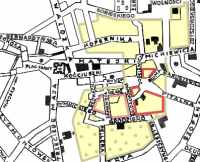 |
| Rzeszow Ghetto Map |
German persecution of the Jews began almost immediately. Upon
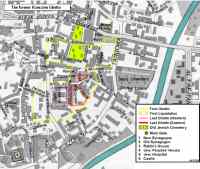 |
| The former Ghetto |
In late September most synagogues were destroyed. Jews were forced to clean the streets*. Then the old Jewish cemetery*, located near the centre of the city, was demolished. Jews had to pull down the cemetery walls, break up all tombstones and pave the roads with the rubble. The emptied area served later as the Sammelplatz for the deportees.
The city was incorporated in the Generalgouvernement. In October a Judenrat was appointed, headed by Dr Kleinmann. The Ordnungdienst, the Jewish police, was formed, initially numbering 25 functionaries and headed by a former Polish officer from Lodz, Gorelik. On 26 October, an edict, issued by Hans Frank, required all Jewish males between the ages of 14 and 60 to register for work. Soon Jews were summoned for forced labour*. With effect from 1 December 1939, all Jews in the
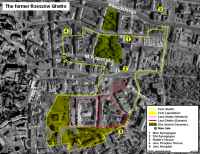 |
| Aerial Photo |
In May 1940 Jewish apartments were confiscated, and Jews were prohibited from using the city's main thoroughfares, Trzeciego Maja and Zamkowa Streets. Later the all night curfew was introduced. All Jewish men had to report at the Arbeitsamt.
In 1940, several hundred Jews from Rzeszow were sent to camps which had been established in Pustkow (near Debica), Jaroslaw and Lipie (near Nowy Sacz).
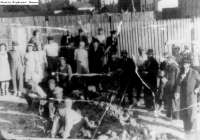 |
| Jews engaged in forced Labour |
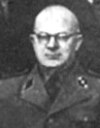 |
| Hans Mack * |
In January 1940, Kleinmann and other members of the Judenrat were executed at the marketplace for failing to provide a sufficient number of forced labourers (according to the Ringelblum archive); Benno (Bernard) Kahana, Kleinmann’s deputy, was appointed head of the new Judenrat. Between December 1939 and January 1940, 6,000–7,000 Jews were deported to Rzeszow from the Warthegau and Upper Silesia, among them 1,800 Jews from Lodz and 1,224 from Kalisz. There were also 630 émigrés from Germany who had arrived in 1938 - 1939. In turn, several thousand Jews, both residents of the city and refugees, left Rzeszow and made their way to Warsaw, to Soviet-occupied Poland or to other places in the Generalgouvernement. Later, only a handful managed to cross the border legally. The deadline for the exchange of refugees between Germany and the Soviet Union was set for 15 May 1940. An order of the RSHA dated 25 October 1940, banned all Jewish emigration from the Generalgouvernement.
By June 1940, the number of Jews in Rzeszow had decreased to 11,800, of whom 7,800 were pre-war residents of the city. At the same time, the number of Jews in the towns and villages of the Rzeszow region were (with the number of refugees in brackets): Blazowa – 931 (139), Czudec 428 (33), Glogow M. – 806 (87), Kolbuszowa – 1,427 (700), Lancut – 900 (502), Niebylec – 570 (20), Ranizow – 620 (63), Sedziszow – 110 (81), Sokolow M. – 1,700 (186), Strzyzow – 1,238 (174), Tyczyn – 500 (140), Zolynia – 700 (103), Lezajsk – (500).
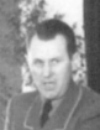 |
| Albert Pavlu * |
The witness Samuel Isak Wilf, testified:
"The ghetto was not established until 10 January 1942. Posters appeared, stating that within 3 to 5 days all Jews had to move into the houses reserved for the ghetto. At that time only the Jews from Rzeszow lived in the ghetto, plus about 2,000 refugees from Lodz etc. The Jews from the surrounding area were left in peace for the time being. Originally the ghetto was big, containing about 20% of the town. Nevertheless, some houses were really crowded, with up to 20 persons in one room. Within the wooden fence around the ghetto 3 gateways were set, guarded by Jewish and Polish police. Only those with a job outside the ghetto were entitled to leave. However ... could bring in some food, so that at first we did not starve."
On 17 December 1941 a decree was issued, establishing a ghetto in Rzeszow, and on 10 January 1942 the ghetto area was closed off, imprisoning approximately 12,200 Jews, more than 3,000 of them refugees and people deported from western Poland. Overcrowding, starvation and lack of hygienic facilities resulted in the inevitable epidemics, in which hundreds died. In March 1942, the Gestapo murdered residents of two houses in the ghetto. On 30 April 1942, the Gestapo murdered another 35 people in the ghetto. They were taken from their homes and shot. On 12 May, 250 Jews from the Rzeszow prison were taken to the Nowa Wies forest, shot, and buried.
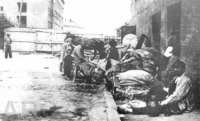 |
| Resettled Jews * |
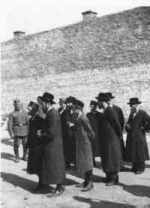 |
| Jews in Rzeszow |
This ghetto was closed in February 1942. In Sokolow Malopolski the ghetto was formed in April 1942. At the time of the ghetto's liquidation in June 1942, 3,000 lived there. During the resettlement to Rzeszow 28 persons were killed. Most of the Jews from the ghetto in Glogow Malopolski were moved to Rzeszow in early July 1942. A number were executed at the Glogow forest (Rudna Forest), situated between Rzeszow and Glogow. Jews, concentrated in the Strzyzow ghetto, were resettled to Rzeszow on 26 April and 9 June, those from Blazowa on 26 June.
By the end of June 1942, all Jews from the smaller towns of Majdan Kolbuszowski, Czudec, Niebylec, and Staniszewska, together with some from Lancut, Sedziszow Malopolski, and from small villages near Rzeszow were forced into the Rzeszow ghetto. As a result, the population of the ghetto rose to almost 23,000.
In June 1942, the responsibility for the entire Jewish population was transferred from the administrative authorities to the Police and SD. At the beginning of July, the Germans imposed a penalty on the Rzeszow ghetto of 1,000,000 zlotys, to be paid by its inhabitants.
The witness Samuel Isak Wilf, testified:
“Afterwards the compulsory labour regulations were tightened up. Most Jews were forced to work. Around the same time came the "contributions". First 2, then another 3, then a further 7 million zlotys, and finally the delivery of all money. The Jews had to pay all tax arrears. Aryans who held claims against Jews were entitled to get paid without delay. Eventually the order came that all Jews from the surrounding area had to move into the town of Rzeszow. Many fled into the forests, but some 11,000 obeyed, so that the ghetto suddenly had some 24,000 inhabitants.”
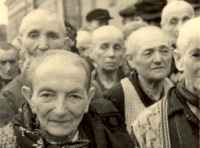 |
| Elderly People, in 1942 * |
 |
| At Staroniwa Station * |
The march to the station on that day was especially brutal. People were herded, beaten with rifle butts and shot on the way, before the eyes of the local population (including German civilians, who officially protested afterwards). 236 people were shot* in the ghetto streets, 42 on the way to the station. Jews who buried the bodies at the Czekaj Jewish cemetery were also killed. Among the executioners were Pavlu and Mack.
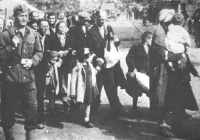 |
| Deportation in Rzeszow * |
Two other transports departed from Staroniwa on 14 and 19 July. Sources differ in estimating the total number of those deported at between 18,000 - 21,000. Since some 4,000 Jews were still living in the ghetto after the July deportations, it may be assumed that a figure of around 20,000 is accurate if this is to include the victims of the mass executions in the Glogow forest and those killed in the ghetto.
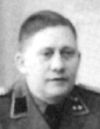 |
| Heinz Ehaus * |
The ghetto was subsequently reduced in size. At the end of July a large group of Jews from the Debica ghetto were brought to the Rzeszow Ghetto. On 7 August, a second Aktion took place, in the course of which approximately 1,000 women and children were taken to the Pelkinie forced-labour and transit camp near Jaroslaw in the Lwow district (there were already 10,000 Jews from Lezajsk, Lancut, Zolynia, Radymno and other places in this transit camp). After a brief stay, they too were transported to Belzec.
On 25 October 1942, a group of 120 Jews from the liquidated Glogow Malopolski ghetto were sent to the Rzeszow Ghetto. A third Aktion was carried out on 15 November 1942. All Jews were gathered at the Appellplatz at Baldachowka Street, where a selection took place. A further 2,000 Jews were sent to their deaths in Belzec. During the course of this Aktion, a large force of Security Police under the command of Paul Lehmann searched the ghetto for children. Any found were killed on the spot.
The witness Samuel Isak Wilf, testified:
“Around this time another action was planned. The Jewish employment agency had summoned all unemployed women and children unfit for work to be registered. A complete company of German police had been hiding in the agency. The women and children were rounded up immediately, their property was taken from them and they were deported to Belzec. There were also 4 men among these people, three of whom were elderly and one a younger man named Holoschek who subsequently sent us a note from Belzec in which he wrote that he was working in hell. At first we did not understand the message, but afterwards we heard that his job was to assist at the burning of corpses. We also heard that some of the women had to work on farms. Later we no longer received any messages. Probably all of these people were killed."
Following this last Aktion there were no more than 3,000 Jews left in the ghetto, which was then reduced still further in size and divided into two separate camps. The section east of Baldachowka Street, called "Camp A", became a Jüdisches Zwangsarbeitslager (Forced-Labour Camp for Jews). "Camp B", west of Baldachowka Street, housed the families of the forced labourers. Ghetto A was subordinated to the Krakow office of SSPF Scherner, not the Rzeszow police office. The first commandant of the camp was SS-Hauptscharführer Bacher, a sadist. Men and women were separated and the camp was organized as a concentration camp. Some of the 2,000 prisoners (those with a "W" badge) worked outside of the camp for different German Army workshops. There was also an Ostbahn” Group, working under a certain Bremmer (or Brehmer). Some Jews laboured in the ghetto workshops under the command of Eintracht. Bacher served as the commandant until March 1943, when, after a conflict with the local Gestapo, he was transferred to the Szebnie camp. He was replaced by SS-Hauptscharführer Kurt Schupke. The ghetto B, or "West Ghetto" (called Schmelzghetto / "Melting Ghetto"), was subordinated to the Rzeszow Gestapo and the Judenrat still functioned there. Family members of Ghetto A workers lived there as well as deported newcomers. On 15 December a group of 600 Jews from the liquidated Krosno Ghetto were transported to Rzeszow and on 14 December, a group of 170 prisoners from the Dukla work camp.
A witness, Hilde Huppert, who had been deported to Rzeszow, described what she had seen in February 1943:
"I stood at the window and saw 20 miserable figures wrapped in rags crouching in the lorry. I did not understand what it meant and asked a native of Rzeszow to explain it to me. That, he said was an incident which repeated itself every six weeks. A few weeks ago these people had left Rzeszow hale and hearty. They were sent to the equipment workshop at Stalowa Wola, not far from Rzeszow, from which they returned as living corpses. They had to work 18 hours a day under violent ill treatment on a diet on which no one could live. When I asked why they brought such sick people here, he explained that the factory only acquired healthy bodies in exchange for the expended human material."
The 20 people were put to bed in a room in the ghetto, but two days later:
"Towards seven o'clock 6 Gestapo men arrived and asked to see the sick workers... In the sick room they ordered the people to get up and run into the square. Whoever could not run would be killed. They chased the poor victims out of bed with blows of the whip and forced the ones who could hardly stand on their feet to run to and fro. The executioners found it so funny that they had to stop their mouths from laughing. Then they began to shoot at the runners… As we reached the West Ghetto we stumbled into puddles of blood… We saw corpses lying in front of our houses."
On 23 March 1943, more than 20 prisoners of the Ostbahn Group were executed. Soon the whole group was dissolved. At the same time a small group of prisoners from Biesiadka camp (a lumber works) returned to the ghetto. In subsequent months most prisoners of the ZAL (Ghetto A) in Rzeszow were transferred to other camps, mostly to Szebnie near Jaslo, and to Stalowa Wola. On 23 July 1943, when the latter camp was evacuated to KZ Plaszow, there were 416 prisoners, including 50 Jews from Rzeszow. An unknown number of Jews were sent to Debie sub-camp, where most probably all were killed. 110 Rzeszow prisoners were transported to Pustkow camp and, upon its liquidation, to Auschwitz and still further to KZ Mauthausen and KZ Gusen. A group of Jews from the Flugmotorenwerk at Lisia Gora, among them 30 originating from the Rzeszow Ghetto, were evacuated to Plaszow. Some 60 Jews from Huta Komorowska sub camp (a lumber works) were brought to Rzeszow and executed there. The rest of the Huta Komorowska workers were executed in the Glogow forest in the summer of 1943.
On 4 September 1943, most inmates of Camp A were moved to the Szebnie forced-labour camp near Jaslo, 129 km southeast of Auschwitz. In early November, some 700 of these prisoners were taken to a forest near the village of Dobrucowa and shot. The last major group (ca. 2,800 Jews) was transferred to Auschwitz on 3 November 1943, where most of them perished. On 6 November, 500 Jews were killed in Szebnie and upon the liquidation of the camp, on 30 December 1943, the last 84 Jews were transported to Plaszow along with 1,000 Poles. Those incarcerated in Camp B in Rzeszow were transported in November to Auschwitz-Birkenau and gassed.
One of the survivors of the 6 November Massacre in Szebnie was Lotka Goldberg, who managed to reach the Rzeszow Ghetto. She was greeted by the "liquidation party", headed by the chief of the Jüdischer Ordnungsdienst (Jewish police) Gorelik and camp commandant Schupke, who said that she deserved the Iron Cross First Class for her escape. Gorelik tried to organise escapes, but he was caught by the Gestapo, tortured and killed. Lotka Goldberg was among a group of 36 Jews, who hid in a bunker dug within the ancient tunnels of Rzeszow Old Town. Only 6 of these fugitives survived when the bunker was destroyed. Lotka Goldberg was captured in another hiding place and transported to Plaszow. On 14 January 1945, she marched from Plaszow to Auschwitz, finally arriving at the KZ Bergen-Belsen, where she was liberated by the British Army.
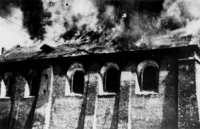 |
| Burning Synagogue, in 1944 * |
The last commandant of the camp Flugmotorenwerk at Lisia Gora was Georg Oester, a man noted for his previous brutal behaviour in the ghetto. As the Red Army approached in the summer of 1944, the factory was dismantled and the machinery sent to Germany. However, before the prisoners could be liberated, they were transferred to Plaszow, where they once again encountered Schupke, this time as the commandant of the camp. After about a week they were sent to KZ Flossenbürg and from there to a factory at Orbis, near the French city of Mulhouse. Because the Allies were advancing from the West, the prisoners were taken to KZ Sachsenhausen, where the group was broken up and sent to various camps in Germany. By the war's end, of the original contingent of about 600 Rzeszow Jews, only a few dozen of them had survived (see Samuel Wilf's story.). Schupke escorted the last group of 500 Plaszow Jews to Auschwitz, on 17 January 1945.
The 1944 edition of Baedeker's "Generalgouvernement Guidebook" describes Rzeszow, known in the mid-19th century as "Little Jerusalem", as a city "formerly dominated by numerous Jews." Of 15,000 Rzeszow Jews, merely 100 survived the war; in Rzeszow itself, in hiding all over Poland, and in various camps. After the war an additional 600 Rzeszow Jews returned from the Soviet Union. Almost all of them subsequently left the city and the country. Schupke, commandant of the eastern ghetto (A), later Jüdisches Zwangsarbeitslager (ZAL) and the last commandant of the Plaszow camp, was sentenced to death by the Krakow District Court, and hanged on 27 November 1948.
Some other defendants accused of crimes in the Rzeszow area either received modest sentences or were acquitted.
Other Trials:
Kiel, 1966, Flensburg, 1963:
Fellenz, Martin - 7 years
(Polizei SSPF Krakow)
Crimes committed in Krakow, Michalowice, Miechow, Przemysl, Rzeszow, Tarnow, June 1942 - August 1942
Subject of the proceeding: Deportation of the Jewish population of Krakow, Miechow, Przemysl, Rzeszow and Tarnow to KL Belzec. Shooting of Jews, who were in no condition to be transported or who were unable march. Shooting of fleeing or “obstinate” Jews from the town of Michalowice during their deportation to the Slomniki Ghetto.
Berlin (DDR), 1968:
Zimmermann, Rudolf - life sentence
(Gestapo Mielec, Gestapo Stalowa Wola, Gestapo Rzeszow)
Crimes committed in Baranow-Sandomierski, Borowa, Charzewice, Krzemjenica, Mielec, Radomysl-Wielki, Rzeszow, Rozwadow, Stalowa Wola, Berdechow forest (near Mielec), Wolka-pod-Lasem, Forced Labour Camp Mielec; Jan 1941 – May 1943.
Participation, as translator and Gestapo employee, in the shooting of hostages, in the deportation and selection of Jews, in individual and mass shootings and in acts of mishandling and statement extortion. In this way the accused took part in the murder of, at least, 1,239 Polish civilians, in the mishandling of 85 civilians in the course of interrogations and in the deportation of at least, 7,100 Jews. He killed 106 Jews single-handedly.
Memmingen, 1970:
Dannenberg, Kurt - acquittal;
Lehmann, Paul - acquittal;
Oester, Georg - life sentence;
Schuster, Adolf - 5 years
(Police Sipo Rzeszow)
Crimes committed in Rzeszow, HS ZAL Flugmotorenwerke Reichshof, in years 1942 - 1944
Group- and single shootings of Jews from ZAL Flugmotorenwerke Reichshof and Ghetto Rzeszow. Participation on Aussiedlungsaktionen. Shooting of Jews who have been in hiding after the liquidation of the ghetto. Shooting of typhus-ill Jews at the ghetto hospital, of in the Rzeszow prison imprisoned Jews, as well as a group of 27 Jews who were accused of having bribed an Ostbahn officer.
Photos:
Stanislaw Kotula, Losy Zydów rzeszowskich *
Collection of the Jewish Historical Institute ZIH *
Sources:
1) Gutman, Israel, ed. Encyclopedia of the Holocaust, Macmillan Publishing Company, New York, 1990
2) Hilberg, Raul. The Destruction of the European Jews, Yale University Press, New Haven, 2003
3) Gilbert Martin. The Holocaust – The Jewish Tragedy, William Collins Sons & Co. Limited, London, 1986
4) Gilbert, Martin. Holocaust Journey, Weidenfeld & Nicolson, London,1997
5) Arad Yitzhak, Gutman Israel and Margaliot Abraham, eds. Documents On The Holocaust, University of Nebraska Press, Lincoln and London, 1999
6) Justiz und NS-Verbrechen: http://www1.jur.uva.nl/junsv/index.htm
7) Reitlinger, Gerald. The Final Solution – The Attempt to Exterminate the Jews of Europe 1939-1945, Jason Aronson Inc, Northvale, New Jersey and London, 1987
8) Poradowski, Stanislaw. Zaglada Zydow rzeszowskich – Extinction of Rzeszow Jewry, Biuletyn ZIH, 1984-93.
9) Kotula Stanislaw. Losy Zydów rzeszowskich 1939-1944. Kronika tamtych dni (The Fates of the Rzeszów Jews. A Chronicle of those Days), Rzeszów 1999.
10) Salton, George Lucius. A Holocaust Memoir, The University of Wisconsin Press, Madison, 2002
 |
| 23,000 Jews lived in the ghetto |
© ARC 2005